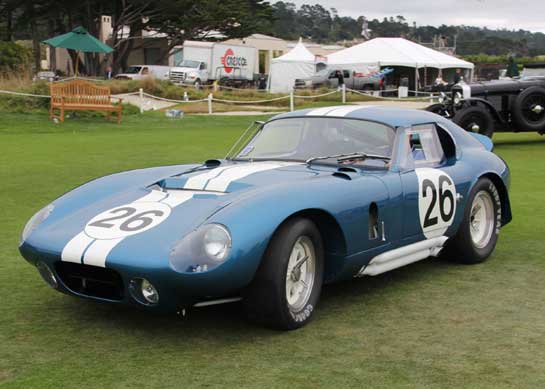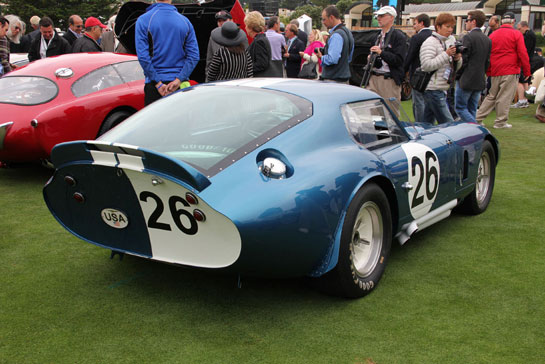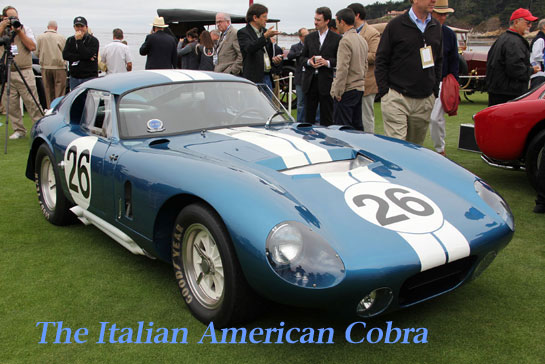By Wallace Wyss
Photos by Hugues Vanhoolandt
Yes, five out of six of the Cobra Daytona coupes, first commissioned in 1964, were bodied in Italy. Which makes them as much Italian-American as, say, the Dual Ghias which were Chryslers bodied in Italy.
The Cobra coupe came about when Shelby reluctantly realized that even with his highly tuned version of the 289 Cobra engine, the roadster would only do 165 mph because it had all the aerodynamics of a brick.
Fortunately he had a young man on his staff, Peter Brock, who had who had worked at GM styling. Brock said he could do an aerodynamic coupe and since Ferrari had mopped up the Cobras with the 250GTO coupe, Shelby was interested.
Actually Shelby had bolted on some semi-fastback hardtops on some Cobras run at LeMans in ’63 but even those could only crack 170 mph. He knew he had to have what Ferrari had, a full fastback.
Brock’s design was claimed by him to be original but there were in fact some ideas used in it that were visible on some 1963 cars like the Aston Martin project cars and the Maserati type 151 and even the Alfa GTZ.
The crew at Shelby American was skeptical of the car until report filtered back from the first test at Riverside that it clocked 180 mph. Shelby had ordered the bodywork for the first one from Bill Honda, an LA craftsman, but he needed it to be faster so on DeTomaso’s recommendation, he chose Carrozzeria Gran Sport in Modena, right in the heart of Ferrari territory.
The Italians got the measurements on the first one wrong and it had a tall windscreen, and Shelby complained but Dan Gurney soon proved it was no obstacle to a good driver. When Phil Hill drove it, he insisted on an aero aid being installed in the back and though Brock didn’t get to use his ring airfoil(later used on his Hino Samurai) Phil Remington cobbled up a Ferrari GTO-like spoiler that kept the rear end planted.

Shelby was pretty vocal about his Daytona Coupes, but rarely mentioned that most of the bodies were built in Italy.
The big feature of the car was the Kamm effect tail . Young Brock, while at GM, had come across some studies by a German aerodynamicist, not Dr. Kamm, but another scientist. Basically as a result Brock wanted a long tail, but found if you hacked the long tail off abruptly you got a Kamm effect tail and that’s what the car had.
They did well enough in the 1964 season except that, according to historian Michael T. Lynch, Ferrari got the Monza race cancelled as far as counting in points for the FIA GT Championship and Ferrari scraped by in points, making Shelby furious. He had been snake-bit (and that was supposed to be his thing…)

The rear airfoiler may have spoiled the lines but Phil Hill knew it would keep the rear end in place. Photo by Hugues Vanhoolandt.
In ’65 that was rectified. Even against the redesigned (by Pininfarina) 250GTOs, the Daytona and the Cobra roadsters won enough points to win Shelby the World Manufacturer’s Championship. Ironically, it wasn’t the Shelby team running the cars, though, it was the Alan Mann Team based out of the UK. Shelby had subcontracted the job because he was busy trying to make the Ford GT a winning car.
Ironically, after their victory, because Ford was now only interested in winning LeMans overall with the faster Ford GTs, the Daytona coupes were treated rather shabbily, parked outside Shelby’s LAX airport plant with FOR SALE signs on the windscreens. Average price: about $6000 each.
It took vintage racing, and the rise of the Shelby clubs to bring them back into popularity and last time we looked, one had sold at roughly $7 million.
The one shown at this year’s Pebble Beach came in third in the postwar closed sports car class, was listed as being owned by Jorge Gregorio & Luis Perez Company, Buenos Aires, Argentina. I’m glad it was a ’65, the ’65 blue paint is so much prettier….
The Author: Wallace Wyss’ Shelby bio, entitled SHELBY The Man The Cars The Legend is available from Iconografix Inc.

In a quite different style, another Italian American Cobra was at Monterey this past August: the 1965 Mercer Cobra, a strange Virgil Exner and Brook Stevens evocation of a Mercer Raceabout. It was coachbuilt in Turin by Sibona – Basano on Cobra 289 chassis CSX2451 delivered by AC Cars Ltd. RM reputedly auctioned it at US$ 660,000 on the 20th.
Best regards
Glad to hear from a famous historian. I only knew about the Exner’s involvement in the Mercer-Cobra, both father and son. I think workmanship was a bit tighter on the Mercer Cobra than the XNR, after seeing them both in person. If you’re keeping track of Italian built Cobras, you have to add the Ghia bodied 427 roadster that had a removable Ghibli-style hardtop, that was dark blue with tank interior and has never been seen since the ’60s (all you barn finders are hereby launched!) . And last but not least is the Ghia bodied Supersonic styled
427 Cobra that appears in English magazines on occasion–turned out either it was a spare chassis that found a discarded body, or the Italian body went on after the British bodied Cobra was crashed. It is reportedly a hellish car to drive and once belonged to one of the Campbells, the land (and water) speed contesters. So that makes three Italian-bodied Cobras before you even get to the Carrozzeria Gran Sport cars.